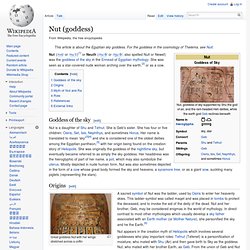

The Egyptian God Family Tree – Veritable Hokum. First: I opened a store!
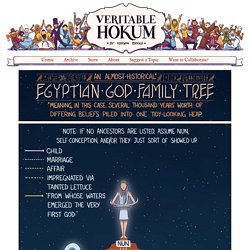
It has a poster of this, as well as updated versions of the Norse and Greek god family trees I did a while back. More to come soon. Next, a disclaimer: this family tree isn’t, strictly speaking, historically accurate, because what we think of as The Egyptian Pantheon is really a whole bunch of similar-but-not-identical pantheons which were mostly based in individual cities – Thebes, Heliopolis, Memphis, etc. – and went through a lot of changes over their 3000+ year history. It’s as nice a chart as I could make after smooshing together a bunch of those similar-but-not-identical pantheons into one image, but it also contains at least a half-dozen gods who were in charge of their own version of this pantheon, and a bunch of others who could be related to each other in totally different ways depending on when and where you asked.
And now that I’ve disclaimed historical responsibility, onto What I Know About Those Gods Up There: Egyptian pyramids found by infra-red satellite images. Seventeen lost pyramids are among the buildings identified in a new satellite survey of Egypt.
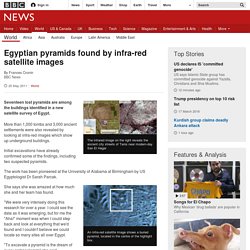
More than 1,000 tombs and 3,000 ancient settlements were also revealed by looking at infra-red images which show up underground buildings. Initial excavations have already confirmed some of the findings, including two suspected pyramids. The work has been pioneered at the University of Alabama at Birmingham by US Egyptologist Dr Sarah Parcak. She says she was amazed at how much she and her team has found. "We were very intensely doing this research for over a year. "To excavate a pyramid is the dream of every archaeologist," she said.
The team analysed images from satellites orbiting 700km above the earth, equipped with cameras so powerful they can pin-point objects less than 1m in diameter on the earth's surface. Infra-red imaging was used to highlight different materials under the surface. Gods and Goddesses.
Egyptian Deities and Myths Compared to the Bible. There are few books that have caused as much controversy as the Holy Bible.
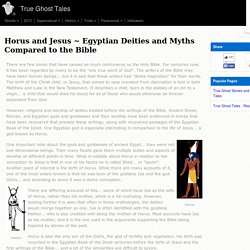
For centuries now, it has been regarded by many to be the "one true word of God". The writers of the Bible may have been human beings... but it is said that those writers had "divine inspiration" for their words. The birth of the Christ child, or Jesus, that comes to save mankind from damnation is told in both Matthew and Luke in the New Testament. It describes a child, born in the stables of an inn to a virgin... a child that would shed his blood for all of those who would otherwise be forever separated from God. However, religions and worship of deities existed before the writings of the Bible. Horus One important note about the gods and goddesses of ancient Egypt... they were not one-dimensional beings. Mésopotamie. Un article de Wikipédia, l'encyclopédie libre.
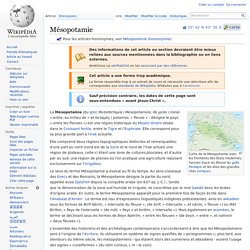
Carte de la Mésopotamie avec les frontières des États modernes, l'ancien tracé du littoral du golfe Persique et les sites des grandes cités antiques. Elle comprend deux régions topographiques distinctes et remarquables: d'une part au nord (nord-est de la Syrie et le nord de l'Irak actuel) une région de plateaux, celle-ci étant une zone de cultures pluviales; et d'autre par au sud, une région de plaines où l'on pratique une agriculture reposant exclusivement sur l'irrigation. L'ensemble des historiens et des archéologues contemporains s'accorderaient à dire que les Mésopotamiens sont à l'origine de l'écriture. Ils utilisaient un système de signes qualifiés de « pictogrammes »; plus tard, aux alentours du IVème siècle, les mésopotamiens - qui étaient alors des sumériens et akkadiens - eurent l'usage des signes « cunéiformes » (du latin cuneus, i, m : le coin). Géographie[modifier | modifier le code]
Osiris myth. From right to left: Isis, her husband Osiris, and their son Horus, the protagonists of the Osiris myth, in a Twenty-second Dynasty statuette The Osiris myth reached its basic form in or before the 24th century BCE.

Many of its elements originated in religious ideas, but the conflict between Horus and Set may have been partly inspired by a regional struggle in Egypt's early history or prehistory. Scholars have tried to discern the exact nature of the events that gave rise to the story, but they have reached no definitive conclusions. Parts of the myth appear in a wide variety of Egyptian texts, from funerary texts and magical spells to short stories. The story is, therefore, more detailed and more cohesive than any other ancient Egyptian myth. Sources[edit] Other types of religious texts give evidence for the myth, such as two Middle Kingdom texts, the Dramatic Ramesseum Papyrus, and the Ikhernofret Stela. Isis (God of nature and magic,Ideal mother and wife as well as the patroness of ) Temple of Isis in Philae, Egypt Isis (Ancient Greek: Ἶσις, original Egyptian pronunciation more likely "Aset" or "Iset") is a goddess in Ancient Egyptian religious beliefs, whose worship spread throughout the Greco-Roman world.

She was worshipped as the ideal mother and wife as well as the patroness of nature and magic. Nephthys. Etymology[edit] Nephthys - Musée du Louvre, Paris, France Nephthys is the Greek form of an epithet (transliterated as Nebet-het, and Nebt-het, from Egyptian hieroglyphs).The origin of the goddess Nephthys is unclear but the literal translation of her name is usually given as "Lady of the House," which has caused some to mistakenly identify her with the notion of a "housewife," or as the primary lady who ruled a domestic household.
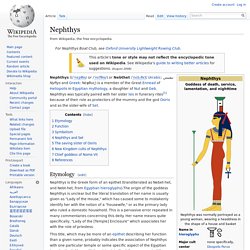
This is a pervasive error repeated in many commentaries concerning this deity. Her name means quite specifically, "Lady of the [Temple] Enclosure" which associates her with the role of priestess. Nut (goddess) Nut (/nʌt/ or /nuːt/)[1] or Neuth (/nuːθ/ or /njuːθ/; also spelled Nuit or Newet) was the goddess of the sky in the Ennead of Egyptian mythology.
